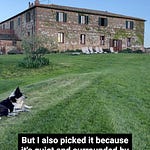Links:
One of my favorite food writer, Emiko Davies
Agata Chrzanowska, PhD, art historian and professional guide in Florence
Pitti Mosaici and the Renaissance art of semi-precious stone mosaic
If you prefer to read, keep scrolling.
Last summer, while I was exploring Florence’s Oltrarno neighborhood, I visited the Santo Spirito church.
In the left aisle of the church, hanging from the ceiling there is a beautiful Michelangelo crucifix. It’s 53 inches long, with a very natural twist of the torso.
But what intrigues me the most about this wooden crucifix is the story of its discovery.
Margrit Lisner was one of the first female professors of Art History in Germany. Her research field was on fifteenth-century wooden crucifixes.
In the 1950s, Dr. Lisner was traveling through Tuscany on her old Vespa (how cool is that?). She was visiting every church in the region to find all the wooden crucifixes so she could classify them for her research.
She was literally opening every dusty drawer and cobweb-filled closet.
When she arrived in downtown Florence, she went to the Santo Spirito church in search of more crucifixes. She saw a neglected crucifix that hung above a door, nobody really paid attention to it before because it had a disfiguring layer of paint. But she immediately recognized it as a Michelangelo, because of its contrapposto.
In visual arts contrapposto refers to a standing human figure that carries its weight on one foot so the other leg bends a little, it's the natural standing position of the human body. The ancient Greeks invented this formula and Michelangelo along with Leonardo da Vinci rediscover it with their work. Michelangelo's David is the perfect example of contrapposto.
But how could she prove it?
She knew that Michelangelo was in the Santo Spirito convent in 1462, when he was a teenage of seventeen. He was studying human anatomy and the Prior gave him permission to dissect corpses from the hospital. To thank the Prior Michelangelo sculpted a wooden crucifix, slightly smaller than a regular adult size, possibly inspired by the body of a 14 years old boy.
It was hung above the church’s main altar. Written sources attest that stayed there until the 18th century. Then we lost track of it.
Dr. Lisner was able to back up her theory by comparing the legs of the crucifix to the legs (right) of Christ in Michelangelo's famous Pietà (left). The legs are so similar, they were clearly sculpted by the same artist.

She saw something that others had overlooked.
As you can imagine, such an important discovery by a foreigner, who was also a woman, angered many local art historians.
I’m telling you this story as a Florentine because this isn’t the only time that an outsider has shown me things that a native might have missed.
When I moved to the US, I fell in love with the work of an Australian-Japanese food writer, Emiko Davies. She captures the essence of Florentine food better than anyone I know. Her recipe for rice gelato (it’s like rice pudding made into gelato) catapulted me back to the hot, sweaty summers of my childhood, my sticky fingers wrapped around an ice cream cone.
And then last summer, I walked through the Oltrarno neighborhood in Florence with the Polish art historian Agata Chrzanowska. I grew up with an unconscious prejudice that Florence is a town that lives in the past, for the past—a museum, more for tourists than Florentines. But when Agata showed me Pitti Mosaici’s workshop where 2 maestros create mosaics with semi-precious stones, just as artisans did during the Renaissance, she opened my eyes. Now I can see that art is still alive and vibrant in my town.
Sometimes, we really need the power of outsiders to gives us new eyes to see the beauty hidden around us.















Share this post